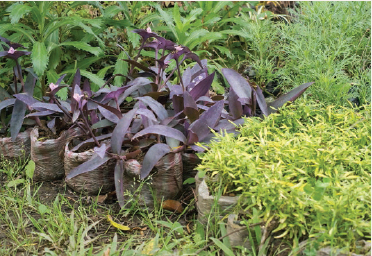
IN MY YEARS OF SHARING plants, I’ve traded plants with older gardeners who gave me things they’d rooted and repotted into milk jugs, paper bags, newspaper rolls, and soup cans. They root at home and then find a container to share the plants in. Some of them are obsessed by the thrill of rooting. Some want plants to share. Some simply wouldn’t think of actually paying for a plant, much less a pot, and just can’t bear to let a potentially free plant get away. Learning to root at home may offer any of these benefits for you. Importantly for all of us, it reduces the environmental cost of producing, recycling, or sending tons of plastic pots to the landfill. Rooting at home can be big-picture stewardship, but it can also be an intimate nurturing of a little living thing. It can be a soulful connection—stories and memories passed between people and plants.
For other gardeners, rooting is the only way to get plants that are not available in nurseries. Quite simply, if you want certain plants, you have to root them. Otherwise, your garden is doomed to be shrubbed only with the limited selection of plants that nurseries and plant promoters put in front of you. Granted, there are many of us in that very business with great taste in plants, but, even if you know its name, you’ll never be able to go out and buy your grandmother’s rose—it’s just not hers.
Cuttings stuck directly into plastic bags are ready to move or give away. While not the best solution, plastic bag pots do use less resources in manufacturing and in transport than thick-walled plastic pots.
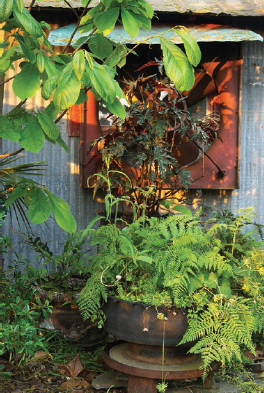
A classic example of recycling. Tire planters make summer homes for large house plants.
Most plants want to root. It’s part of their physiology, a way of reproduction. Sometimes it even happens by accident, like when you stick a bit of rosemary in a glass of water to keep it fresh and all of a sudden you see tiny white roots. Rooting in water is easy, in fact, but getting that rooted plant to transfer to the dirt can be challenging. In water, the fine white root hairs are perfectly filled with water, but when you transfer them, those hairs are damaged and traumatized to such a degree that the new plant often dies in the process. Still, there are hundreds of different shrubs, perennials, and trees that will root right in the ground. People have been taking advantage of this for ages, and we’ve learned many workarounds for plants that are a bit more difficult to root. I have friends who embrace the challenge, who’ve built entire professional careers on figuring out how to root impossible-to-propagate plants. It’s hard not to admire a person who spends their free time hunting down and naming new rhododendron species in wild, virtual deserts, and then figures out how to root them using humus collected from the same woods. It takes an amazing passion for that work; an impressive level of devotion. For the rest of us, though, there are many, many more plants that will root easily. I tend to focus on those in my work.
My mother’s garden is made of up plants she’s rooted herself, often from the gardens of friends, relatives, and mentors. Perennials, shrubs, vines, and fruit trees remind her of those people and their connections.
A few simple lessons will open a world of new plants—and an endless supply of free plants—and maybe even change the way you design your garden. Unlike a lot of modern gardens assembled from nursery shopping trips with one of this and one of that, gardeners who root tend to have more repetition in their gardens. Repetition provides beautiful, romantic continuity to gardens; it’s something that both garden designers and visitors love. But the most important lesson to start with is to realize that it doesn’t have to be difficult; there is very little investment—just a few snips and squirts. Take ten cuttings and don’t worry if only two root; just enjoy the successes.
The Teachers
RUTH KNOPF AND GLORIA FARMER
Two women taught me to root in the ground: my mother, Gloria Farmer, and my friend and mentor, Ruth Knopf. Both are in their seventies, and both have been rooting since they were little girls. They’ve made amazing gardens with homegrown, handcrafted plants. Compelled by the magic of rooting, of helping and watching that little cutting grow into a beautiful plant, they can still recall the women who first taught them to root. It’s a secret of life that keeps getting passed down, in moments when a mentor and a child share in the spirit that’s contained in all living things. Eventually, that child roots her own, and the next year, her yard is filled up with plants that were given or broken off in that exchange. Soon, she’s getting a cutting here and there, and her rooting bed is overflowing, and she’s taking plants to the church, the fire station, and even showing up at someone else’s yard sale with a few hydrangea that need a home.
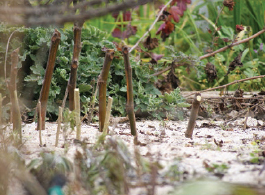
Cuttings stuck in the sand can be transplanted to pots or moved directly to the garden. A bare twig of a shrub can be a new plant in less than a year; a perennial can transform itself in weeks.
My mother, Gloria Farmer, passes it down to her granddaughter.
Ruth and Gloria root reminders. Walking through their gardens, they recall Urbana, who shared her “chicken rose,” or reputed bootlegger Greg’s appropriately named “bootlegger rose.” In a way, they root little companions, alms of the people from whom the cuttings came. Growing up in tighter times, regular visits to the nursery to populate their gardens weren’t an option, and if they were, they might not have had gardens full of such time- and climate-tested, tough plants, anyway. Rooting lets you take a bit of certainty—an edited lesson from a knowledgeable gardener who wants you to succeed—home with you. I can hear both of them visiting their friends’ gardens and saying, “I think I have a place for that, may I take a little cutting?”
Ruth and Gloria root things in designated rooting beds with the idea that they’ll move them to the garden later. Their processes differ slightly: Ruth roots in the summer, Gloria in the winter. Other people do things in totally different ways: rooting by a spigot, by the compost pile, or rooting right in the place where the plant will grow for the rest of its life. In other parts of the world, people stick stripped stems, that will become woven fences, sculptures, and flowing masses of soil-stabilizing groundcover.
Ruth Knopf was a preacher’s wife. She traveled, cooked, and busied herself with the church and her husband. Her personal loves were her family, horses, and roses. I met her much later in her life, after she had redefined herself as a rosarian, internationally recognized for her work in preservation and design with antique roses. From a beach bungalow on the quiet end of Sullivan’s Island, South Carolina, Ruth’s passion led her to spot long-lost roses in country gardens—in the South, in the West, in Bermuda, in Mexico, and just about anywhere you can name in Europe. Quiet and unpretentious, Ruth has given lectures from New York to Los Angeles, telling her stories of collecting old roses and saving them from extinction. A mutual friend, a professional horticulturist, told me not long ago, “When I water my garden, I think of Ruth’s trip to Bermuda and Ruth’s trip to Orlando; every rose is a cutting from Ruth’s travels.”
Ruth taught me that while most people are always saying you should root in the winter, whatever the season, you’d best seize the moment because you may never come this way again. If you don’t act fast, that rose might soon be paved over by a parking lot or “cleaned up” by a well-meaning fella with a weed eater. And in the summer, of course, you can actually see the flower, so you know what you’re getting. Over the years, Ruth has perfected a surefire way of taking summer cuttings of roses and shared her methods with many people. Fortunately, her lessons will work on lots of other shrubs, too, from azaleas to weigelas.
She’s found that the perfect time to take a cutting is a few weeks after flowering. Find a flowering stem with a faded flower or, better yet, with a fruit that’s just starting to form. Follow down the stem about five inches and bend it there. If the stem bends and is completely flexible, it’s not quite ready. And if it snaps off cleanly, completely, it’s past ready. However, if it bends just a little and one side breaks, or sort of splinters, revealing whitish, green wood—that’s what you’re looking for. That will make a great summer rose cutting.
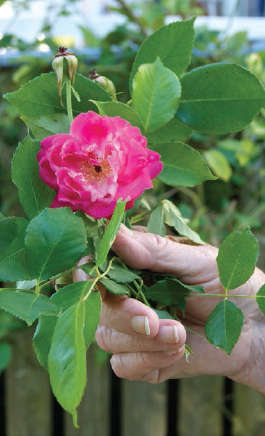
Ruth holds a handful of cuttings, showing that the perfect time to root roses in the summer is just as the hips (top) begin to form.
Ruth speaks from decades of experience rooting roses that are often unique. She’ll knock on any door, anywhere, and ask about a plant, though she rarely asks directly for a cutting: “We were just riding by and saw your beautiful flowers. We just want to say how beautiful it all is. Could we take a picture? What do you call that?” Soon she’s in a deep conversation and invited to have a bit of anything in the garden. This isn’t manipulation, though; it’s just her good manners. Ruth learned from experience that when you come across something special, or even something you simply haven’t seen before, you’d better get a cutting. In her lectures, Ruth always tells the sad story of Mr. Willie. Driving the backroads of South Carolina, she spotted an old man on his porch, behind a yard full of flowers. This was Mr. Willie, smiling, and waving to passersby. She stopped to say hello, and walked through the yard with him, and just before she left, asked if she could take his picture. He said, “People take pictures of my flowers. No one ever asked to take a picture of me.” Months later, Ruth went back to visit—and for cuttings—only to find that Mr. Willie had died, and his flowers had been cleared away.
I have an aster I rooted from Ruth, which she rooted from Fanny, her housekeeper in the 1970s. That aster thrives in the South’s humidity, when almost all other garden asters rot. Fanny’s aster is a spectacular plant for many reasons. Its masses of lavender in October are layered with my memories of Ruth giggling and telling me stories about Fanny and teaching me that purple flowers in the garden soften the transition between other colors.
Any old barn, house, or graveyard is a reason to stop to search for tough old roses and bulbs while touring the backroads.
Ruth took me under her wing—or, to be more precise, into her gold, 1979 El Camino Conquista—and we drove through backroads peeking into old gardens, roadside shacks, and cemeteries looking for roses to root. We had the most fun in the country gardens of old ladies and gentlemen, like Bennett Baxely, a man who grew up scavenging plants, and who would became a mentor and friend to me for more than twenty years. We made lots of these southern visits, and we filled up that El Camino with scavenged plants and bags full of cuttings. Our travels took us even further south; I’ll never forget arriving late one night in Tequila, Mexico, just Ruth and me in a tiny car full of cuttings and cameras. Much to our surprise, the Festival of the Virgin of Guadalupe ensured that every room was booked and the town was packed with bands and revelers. Finally, we found a single, concrete room with bunk beds, no screens, and a bathroom two floors down. Fortunately, it did have a sink that we could use for soaking our cuttings. Between the marching bands, the celebratory gunfire, and the roosters, we barely slept and spent all night giggling to each other—this was real rose rustlin’.
But whatever its success rate, my take on techniques like willow water is that there is a lot more to them than just science. For example, every time I make it, I think back to Malcolm telling me about it. Again, there is that soulful connection, a sense of tradition, memory, and satisfaction. By engaging in these cost-free experiments, we are bringing ourselves closer to our plants and our past.
Of course, rose cuttings will certainly root in the winter, too. That’s how my mother does it. She’s had a little rooting bed for years. When I asked her where she learned, she fondly recalls growing up poor and happy in the swamps of Crocketville, South Carolina:
I remember grandmother rooting camellias and azaleas in the ground. She had a little spot, and she’d put mason jars over them. Like the glass cloches of wealthier gardeners, the glass keeps the humidity up and encourages rooting. I’ve seen people use plastic bottles, bags, or even food-container covers—anything mostly transparent works. She’d root things in the spring and summer, probably when they were blooming. But I root lots in the winter.
Gloria uses old cake and cheese plate covers to hold humidity around cuttings.
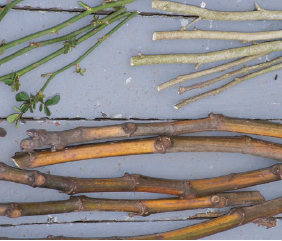
Roses (upper left,) figs (middle), and rose of Sharon (upper right) cuttings.
Professional horticulturists and nursery managers, right up until the 1970s, commonly used winter, in-the-ground rooting. Even in the early 1980s, in my nursery and propagation course at Clemson University, we studied how winter cuttings work. The best time for taking winter cuttings differs with your climate. Dormancy is key—otherwise, the cuttings may try to leaf out or they may use energy for shoots that they can’t support, rather than roots. Start winter cuttings anytime after the plants go dormant. “I usually start them when the pecans fall in October or November,” says Gloria. Another way to remember to do it is to stick the cuttings in the ground or in your rooting bed when you plant pansies. Some people simply stick cuttings in with the pansies, directly in the ground. In late spring, when the pansies need to come out, the rooted cuttings are ready to move. In places with colder winters, you simply root in the spring and through the summer.
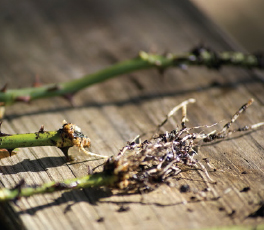
After just two months, callus tissue forms and a few early roots, too.
When you take a pencil-size cutting—any cutting, from anywhere—if it’s healthy, the wood will first start to heal itself. Try to make a sharp angled cut at the bottom, near a leaf bud. Then stick it in the dirt; as it sits there all winter, a callus forms over the bottom, cut end. Later, as the ground temperature changes, roots start to grow from that callus. However, this all depends on having soil that hasn’t frozen solid. In climates where the soil does freeze, you’ll mostly follow the same process, but you’ll want to bundle the cuttings and lay them horizontally and bury them in deep sand, which doesn’t freeze; there they will begin to form that callus. Then, you stick them in the spring. Anywhere you do this, and everytime you do this, some cuttings will fail. In the South and the West, for example, a warm winter cuts into the survival rate, as the cuttings can grow leaves rather than roots. Other things can go wrong, too, such as rotting or rodent damage. But if you start out with plants that are easy to root, even if you lose a few, you’ll have tons of plants in just a few years.
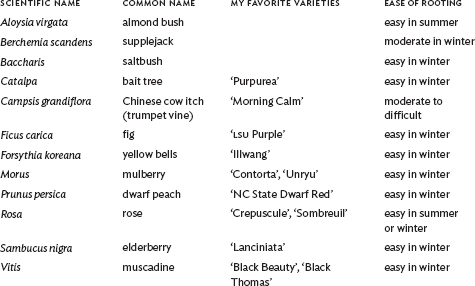
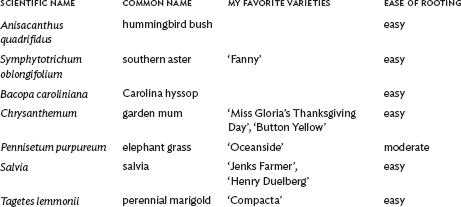
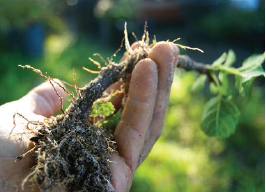
Fig cutting rooted after two months in the ground.
By spring, this rooted cutting has become its own plant and will start to leaf out. Many professionals suggest leaving that new plant in place until midsummer, but I often move things in the spring because the days are cooler, there’s more rain, and they settle in more easily. Gloria is more laid back about the timing: “I move them when they seem ready and when I have time.” What she means by “when they seem ready” is that when she pulls on the cuttings and they don’t pull up easily, she’ll dig one to evaluate their eager white roots.
One of her mentors, Urbana Vaughn, taught her some rooting tricks that have been passed on for several generations. Urbana often shared a rose she called the chicken rose. As a little girl, in the 1930s, she and her sister were in charge of feeding and cleaning the chicken yard. This included the process of burying dead chickens. To mark the graves, they stuck cuttings of a pink climbing rose; forever after, ‘Climbing Old Blush’ was known as the chicken rose. Urbana rooted plants the same way that her mother did, right in the ground. She showed us her method of putting a cutting in the ground at a slight angle, then stomping down on the ground right beside it. And she does all of this in the same place that her mother did, a shady bit of open ground right at the edge of the house, where rainwater from the roof seeps over the plants.
Walking through her own garden, Gloria points out the wavy leaves of the unique noisette rose that she rooted from Urbana, along with many other shrubs that tell stories of old friends. A fig tree with huge purple fruits came from Bill Adams; a pearl bush, in full flower, from Urbana; roses from her sister-in-law and from the old man she used to take meals to for Meals on Wheels; and lots and lots of plants that just say “Ruth’s” on the tag. ‘Mrs. Henrietta Washington’ rose came from another lady, about which she confides, “I lost that one once, but since I had given cuttings to Riverbanks Botanical Garden, when I lost my plant, I got cuttings and have Henrietta’s rose again.”
Gloria’s advice is endless. She says, “Regular hydrangeas are easy, but oakleaf is a bit more difficult. With oakleaf, you can do it in the summer but be sure to take all the leaves off.” She does woody perennials this way, too: chrysanthemum, salvia, perennial marigold, phlox, almond bush, and butterfly bush. Sure, she sometimes buys new plants, as well—but only one of each plant. Then she gets to work, often through trial and error, making cuttings of that new plant. She experiments, and then shares with friends who also root; this is her learning and sharing process.
She roots so much, in fact, that it becomes a constant dilemma in our little nursery on the farm: the rooting bed, which Gloria and I share, is always overflowing. I root a few special things for clients, things that other nurseries just don’t offer, or things I want to use in a garden design in such numbers that it would otherwise be cost prohibitive. But for me it’s mostly a hobby bed, a place to save the cutting someone gave me as a means of remembering a trip, a garden, or a friend. It ends up being really diverse as a result: there are red roses from China, Imperial chrysanthemum from Japan, salvia from Mexico, and rose of Sharon from a cemetery on Long Island. But Gloria’s plants usually crowd out mine. She pots them up and plants what she can find room for. When she’s out of room, she wonders if she could plant one at her friend’s, her sister’s, and her rental house. For the most part, though, it’s the process that matters most to her. She’ll load potted plants into her truck and give them away at the yard sales and fundraisers for the local historical society. Then the rooting bed is cleared, fresh sand is added, little rows are lined up, and the cycle of our rooting life continues.
Updates and Adaptations
When I told him that I don’t know any one person in particular who inspired me to use a variation on rooting in the ground, Felder Rushing, horticulturist and southern garden expert, told me, “You were just raised right.” Instead of sticking cuttings into a rooting bed, I do so in the garden to create a quick mass. This is a great money-saving technique that’s been used in gardens through the ages. Where the gardener knows how to root, there is a nice consistency, a repetition to the plants, rather than a garden of single-specimen plants. Rooters simply can’t throw things away, so they get plant repetition by default. I don’t like seeing gardens where you can count how many pots the gardener just bought. So, for mass, repetition, and maturity, when I plant new plants, and new gardens, I often break off bits, stick them in the ground around the original plant.
The most common use of direct cuttings is with willow hedges. It was common in English gardening, often associated with willow basket making, but also seen in New England and the Northwest. I first saw it done in a garden in Vancouver, BC, then later in beautiful, tidy allotment gardens outside of Copenhagen, Denmark. They call these little spaces Kolonihavers, or colony gardens, because they are gathering places, mini retreats and colonies where the gardener can attend to her gardening bug and be surrounded by others who share their obsession.
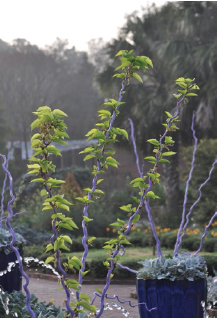
Contorted mulberry limbs, painted and stuck in pots for winter decor, will root in, leaf out, and grow in just a few months. These are from Riverbanks Botanical Garden in South Carolina.
For willow hedges, use dormant, 1-inch-thick willow stems, up to 4 feet long. Bury them halfway, usually at an angle, in a line. They callus and root over the winter, then start to grow in the spring. As they grow, you twine the flimsy stems together to create a woven, tight fence. Some people get creative and make arches or designs. This artful fencing works best in climates with shorter, cooler summers than anywhere I’ve ever gardened, because in warm places, the willow roots and then grows out of control, requiring weekly pruning.
I take this on a slightly different track. In new gardens or if I’m gardening with a new plant that is hard to come by, I use a variation of the technique to create masses. In one garden, I planted a single, small plant of cut-leaf elderberry, which has been difficult to obtain in the South, since most Sambucus nigra cultivars don’t thrive in that climate, but there is a cultivar called ‘Lanciniata’ that does. It stays small and provides really light shade, so I love to use it over small perennials. In this garden, I planted one and waited until Thanksgiving; then I took 6-inch cuttings and stuck them directly in the ground, covering 10 square feet. The mass of elegant, lacy leaves now makes a filigree cover over white-top sedge and purple Stokes’ aster. This was an easy, cheap way to make a beautiful garden with a rare plant.
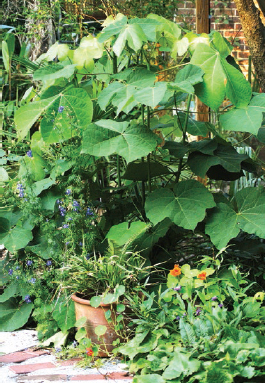
Parasol tree rooted in place from 2-foot-tall cuttings.
Plants like willows and elderberry root easily, as we would expect, but I’ve also used the same technique with figs, mulberry, catalpa, cestrum, and parasol tree. I usually take 10- to 12-inch cuttings, but I learned by accident that you could do the same with really big cuttings. One winter, my dog, Jack, kept digging up everything that I was mulching. The mulch had chicken manure in it, and he’d gobble it all up, digging up little plants and leaving them to die in the process. To stop the massacre, I had to devise an attractive, effective fence. I cut 3-foot long, 2-inch round stakes of Chinese parasol tree. I stuck the beautiful, waxy green stems all around my beds, deep in the sandy soil. A dozen years later, long after Jack could dig up anything, I still have a hedge of parasol trees in that spot. As a tribute, when I buried him, I marked his grave with that same Chinese parasol tree.
People root things in so many different ways; I’ve heard so many success stories. Once you learn, once you get that obsession, you can produce thousands of plants. You can do it in the summer or in the winter, and in dirt water, Jello, or floral foam. I remember an old camellia guy who had his rooting beds perched right by a stream so the moisture from the soil kept the humidity up; there was so much good energy in the air, swept in above the flowing water. Many old gardens lined with miles of boxwood hedges got lined with boxwood cuttings first. If it’s a look you like, learn to root—you’ll save thousands of dollars and have extra plants to give away. It’s a joyous revelation. We can make life, we can promote it, be a part of it; it never goes away. Every time I shear, prune, or break a branch, I want to save it, to stick it, to share it, and to know that the fragile, twig will live on to be a tree or a shrub—something with a life of its own.
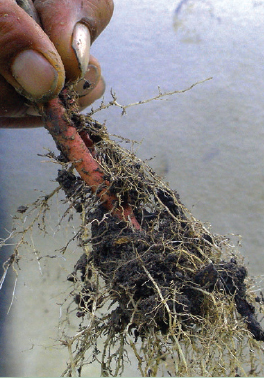
Fresh new roots on a recently “stuck” shrub. This plant could be potted up to give away or simply moved straight into the garden.
I root them like a gardener, the way my great-grandmother Pearl showed me—not production oriented and high-tech like I learned in college horticulture classes. Pearl also taught me that I didn’t have to look for a five-leaflet leaf to know where to prune roses, that they would bloom just fine when simply whacked back to whatever size we wanted, whenever needed.
“Proper rosarians” root rose cuttings dipped into rooting hormones, inserting them in good soil and covering them in winter with clear plastic or glass to protect from freezes. But Pearl was a no-nonsense gardener who had me simply wait until sometime after autumn’s first frost to stick pencil-size cuttings partway into ordinary garden soil that’s been amended with fresh compost, and they would be rooted by spring. This works also in pots of garden loam enriched with compost.
Because only about half of what we put in the ground actually rooted, I learned to simply stick twice as many cuttings as I want to root. Any extras are lagniappe to share with friends and neighbors.
So every winter now, I make flowerbeds do double duty, by pushing rose cuttings into soft soil between cold-weather-loving pansies or violas. Whatever it takes to keep the flowers growing well is good for the cuttings, too. By late winter their cut ends will be covered with knobby white callus tissue that sprouts into new roots just about when it’s time to replace winter flowers with summer stuff. I transplant the rooted cuttings into pots where they remain until time to be sent to their final garden homes.
You don’t need a greenhouse, chemicals, or special potting soil to root plants. These roses are rooting outside and potted in Mississippi mud.
There is no question that the rules are there to help us be successful. But gardening can also benefit from thinking outside the box, and there’s something to be said for less fuss and worry. Pearl’s methods are tried and true, and they have worked for centuries. Pass it on.